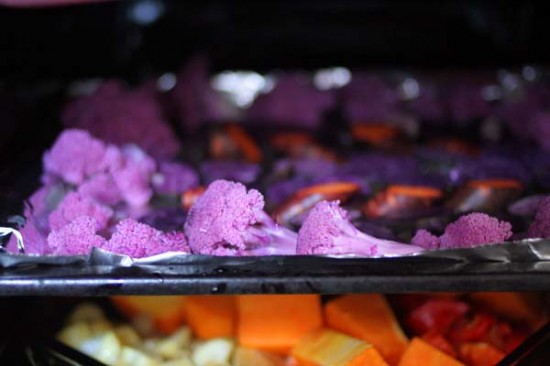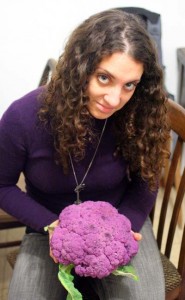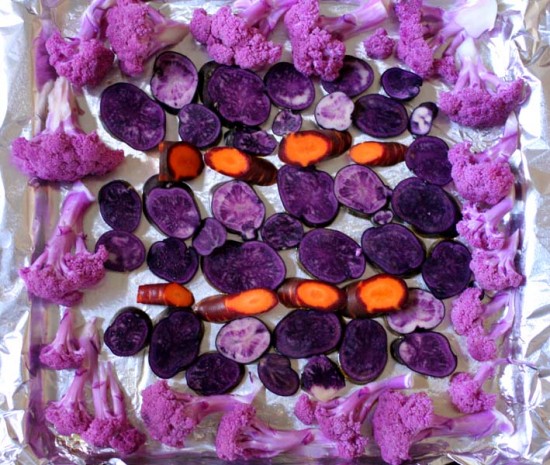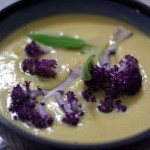Purple food week

I’m such an easy sell when it comes to weird vegetables. This Friday afternoon, we made it to the farmer’s market in the Tel Aviv port for the first time. We arrived late, after most of the stands had begun to pack up, but those left had an amazing assortment of vegetables in colors you (OK, I) would least expect.
UPDATE: PURPLE RECIPES POSTED SO FAR
- Jan. 5: Saturday brunch: Lahoh, purple salad with ginger-dill dressing and more
- Jan. 6: Soup with purple cauliflower and blue cheddar
- Jan. 7: Purple potato salad with lemon and cilantro
- Jan. 8: Tomato salad with purple onion and pepper
- Jan. 9: Pasta with purple cauliflower and walnut cream sauce
- A Jan. 7 article Ynet coincidentally ran about purple veggies (in Hebrew).
- And more: A list of my most recent posts about purple food.
 We wound up leaving with purple potatoes, multicolored carrots, a purple cauliflower and red lettuce (yeah, yeah, boring, but sometimes you need lettuce). In any case, we now have no small quantity of vegetables in weird colors, and I need to find a way to use them.
We wound up leaving with purple potatoes, multicolored carrots, a purple cauliflower and red lettuce (yeah, yeah, boring, but sometimes you need lettuce). In any case, we now have no small quantity of vegetables in weird colors, and I need to find a way to use them.
 The purple cauliflower was by far my favorite purchase; it matches my sweater, my stovetop percolator, and the other assorted purple vegetables I have in the house right now (see photos). The men at the stand said their Netanya-area farm, Moshav Geulim, created these unusually colored cauliflowers by grafting the plants with beets (for purple), pumpkin (for orange) and cucumber (for green); however, I found several sources online that said such cauliflowers are the result of natural mutations. UPDATE: Upon further questioning, they explained that the plants are indeed variations developed in the U.S. by crossbreeding with the above-mentioned plants, not by grafting.
The purple cauliflower was by far my favorite purchase; it matches my sweater, my stovetop percolator, and the other assorted purple vegetables I have in the house right now (see photos). The men at the stand said their Netanya-area farm, Moshav Geulim, created these unusually colored cauliflowers by grafting the plants with beets (for purple), pumpkin (for orange) and cucumber (for green); however, I found several sources online that said such cauliflowers are the result of natural mutations. UPDATE: Upon further questioning, they explained that the plants are indeed variations developed in the U.S. by crossbreeding with the above-mentioned plants, not by grafting.
I set the cauliflower on my table, admired it, and took a ridiculous number of photos, before deciding to roast some florets and add them to a white cauliflower cream soup (recipe later this week).
The cauliflower itself tasted good, although no different from the boring, white version. After being roasted in the oven, it came out a lovely lavender.
 We also took home two large bunches of white, yellow, red and purple carrots, also from Geulim. Apparently these colors have been around even longer than the orange version, which was first cultivated by the Dutch in the 16th century, according to the World Carrot Museum in Britain, which published a long essay on the history of the carrot (Can you believe there’s a world carrot museum? Can you believe someone wrote this much about carrot history?) In any case, the white carrots baked into a beautiful yellow, while the purple carrots were disappointingly orange inside — although they looked interesting when cut into rings.
We also took home two large bunches of white, yellow, red and purple carrots, also from Geulim. Apparently these colors have been around even longer than the orange version, which was first cultivated by the Dutch in the 16th century, according to the World Carrot Museum in Britain, which published a long essay on the history of the carrot (Can you believe there’s a world carrot museum? Can you believe someone wrote this much about carrot history?) In any case, the white carrots baked into a beautiful yellow, while the purple carrots were disappointingly orange inside — although they looked interesting when cut into rings.
 Last but not least (not counting the lettuce), we picked up a box of purple vitelotte potatoes, grown on Moshav Tzofit. These are likely most familiar as the blue potato chips sold at natural food stores. Native to South America, they’re supposed to have a light nutty taste (They didn’t when raw).
Last but not least (not counting the lettuce), we picked up a box of purple vitelotte potatoes, grown on Moshav Tzofit. These are likely most familiar as the blue potato chips sold at natural food stores. Native to South America, they’re supposed to have a light nutty taste (They didn’t when raw).
UPDATE: When eaten alongside regular potatoes, you can tell that the vitelottes are slightly sweeter and do, indeed, have a richer, nuttier flavor.
I should add that all of these purchases were great deals — 15 shekels for the box of potatoes, 5 shekels for a 1-kilo-plus cauliflower and another 5 shekels for 1-kilo-plus carrots. Maybe this is because we came at the end of the day. In any case, we have our cooking cut out for us.

So this week, everything I post will have something purple about it — and we’re not talking eggplant or beets.
FOR MORE INFORMATION:




